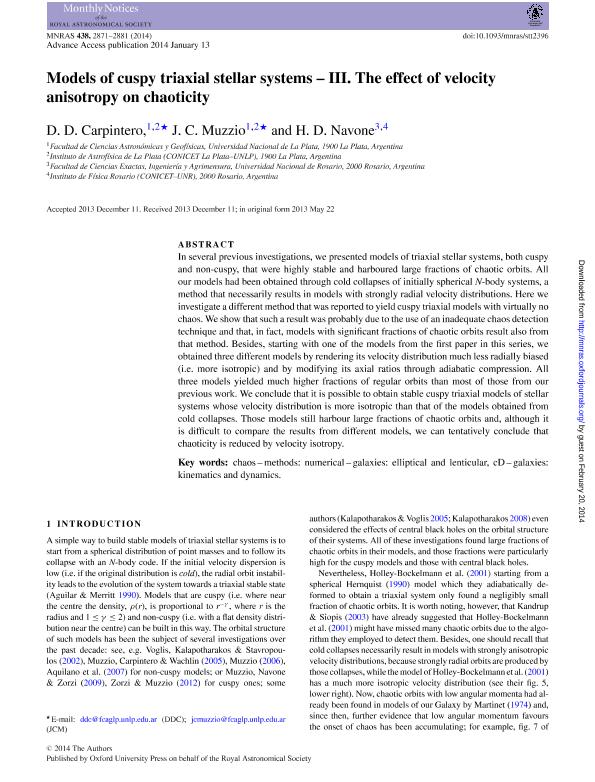Mostrar el registro sencillo del ítem
dc.contributor.author
Carpintero, Daniel Diego

dc.contributor.author
Muzzio, Juan Carlos

dc.contributor.author
Navone, Hugo Daniel

dc.date.available
2017-12-27T17:28:01Z
dc.date.issued
2014-03
dc.identifier.citation
Navone, Hugo Daniel; Carpintero, Daniel Diego; Muzzio, Juan Carlos; Models of cuspy triaxial stellar systems. III: the effect of velocity anisotropy on chaoticity; Wiley Blackwell Publishing, Inc; Monthly Notices of the Royal Astronomical Society; 438; 4; 3-2014; 2871-2881
dc.identifier.issn
0035-8711
dc.identifier.uri
http://hdl.handle.net/11336/31661
dc.description.abstract
In several previous investigations we presented models of triaxial stellar systems, both cuspy and non cuspy, that were highly stable and harboured large fractions of chaotic orbits. All our models had been obtained through cold collapses of initially spherical N-body systems, a method that necessarily results in models with strongly radial velocity distributions. Here we investigate a different method that was reported to yield cuspy triaxial models with virtually no chaos. We show that such result was probably due to the use of an inadequate chaos detection technique and that, in fact, models with significant fractions of chaotic orbits result also from that method. Besides, starting with one of the models from the first paper in this series, we obtained three different models by rendering its velocity distribution much less radially biased (i.e., more isotropic) and by modifying its axial ratios through adiabatic compression. All three models yielded much higher fractions of regular orbits than most of those from our previous work. We conclude that it is possible to obtain stable cuspy triaxial models of stellar systems whose velocity distribution is more isotropic than that of the models obtained from cold collapses. Those models still harbour large fractions of chaotic orbits and, although it is difficult to compare the results from different models, we can tentatively conclude that chaoticity is reduced by velocity isotropy.
dc.format
application/pdf
dc.language.iso
eng
dc.publisher
Wiley Blackwell Publishing, Inc

dc.rights
info:eu-repo/semantics/openAccess
dc.rights.uri
https://creativecommons.org/licenses/by-nc-sa/2.5/ar/
dc.subject
Galaxies
dc.subject
Galactic Kinematics
dc.subject
Numerical Methods
dc.subject
Physical Data
dc.subject
Chaos
dc.subject
Physical Processees
dc.subject
Galactic Dynamics
dc.subject.classification
Astronomía

dc.subject.classification
Ciencias Físicas

dc.subject.classification
CIENCIAS NATURALES Y EXACTAS

dc.title
Models of cuspy triaxial stellar systems. III: the effect of velocity anisotropy on chaoticity
dc.type
info:eu-repo/semantics/article
dc.type
info:ar-repo/semantics/artículo
dc.type
info:eu-repo/semantics/publishedVersion
dc.date.updated
2017-12-05T15:20:38Z
dc.journal.volume
438
dc.journal.number
4
dc.journal.pagination
2871-2881
dc.journal.pais
Reino Unido

dc.journal.ciudad
Londres
dc.description.fil
Fil: Carpintero, Daniel Diego. Consejo Nacional de Investigaciones Científicas y Técnicas. Centro Científico Tecnológico Conicet - La Plata. Instituto de Astrofísica La Plata. Universidad Nacional de La Plata. Facultad de Ciencias Astronómicas y Geofísicas. Instituto de Astrofísica la Plata; Argentina. Universidad Nacional de La Plata; Argentina
dc.description.fil
Fil: Muzzio, Juan Carlos. Universidad Nacional de La Plata; Argentina. Consejo Nacional de Investigaciones Científicas y Técnicas. Centro Científico Tecnológico Conicet - La Plata. Instituto de Astrofísica La Plata. Universidad Nacional de La Plata. Facultad de Ciencias Astronómicas y Geofísicas. Instituto de Astrofísica la Plata; Argentina
dc.description.fil
Fil: Navone, Hugo Daniel. Universidad Nacional de Rosario. Facultad de Ciencias Exactas, Ingeniería y Agrimensura; Argentina. Consejo Nacional de Investigaciones Científicas y Técnicas. Centro Científico Tecnológico Conicet - Rosario. Instituto de Física de Rosario. Universidad Nacional de Rosario. Instituto de Física de Rosario; Argentina
dc.journal.title
Monthly Notices of the Royal Astronomical Society

dc.relation.alternativeid
info:eu-repo/semantics/altIdentifier/url/https://academic.oup.com/mnras/article/438/4/2871/1088216
dc.relation.alternativeid
info:eu-repo/semantics/altIdentifier/doi/http://dx.doi.org/10.1093/mnras/stt2396
Archivos asociados
